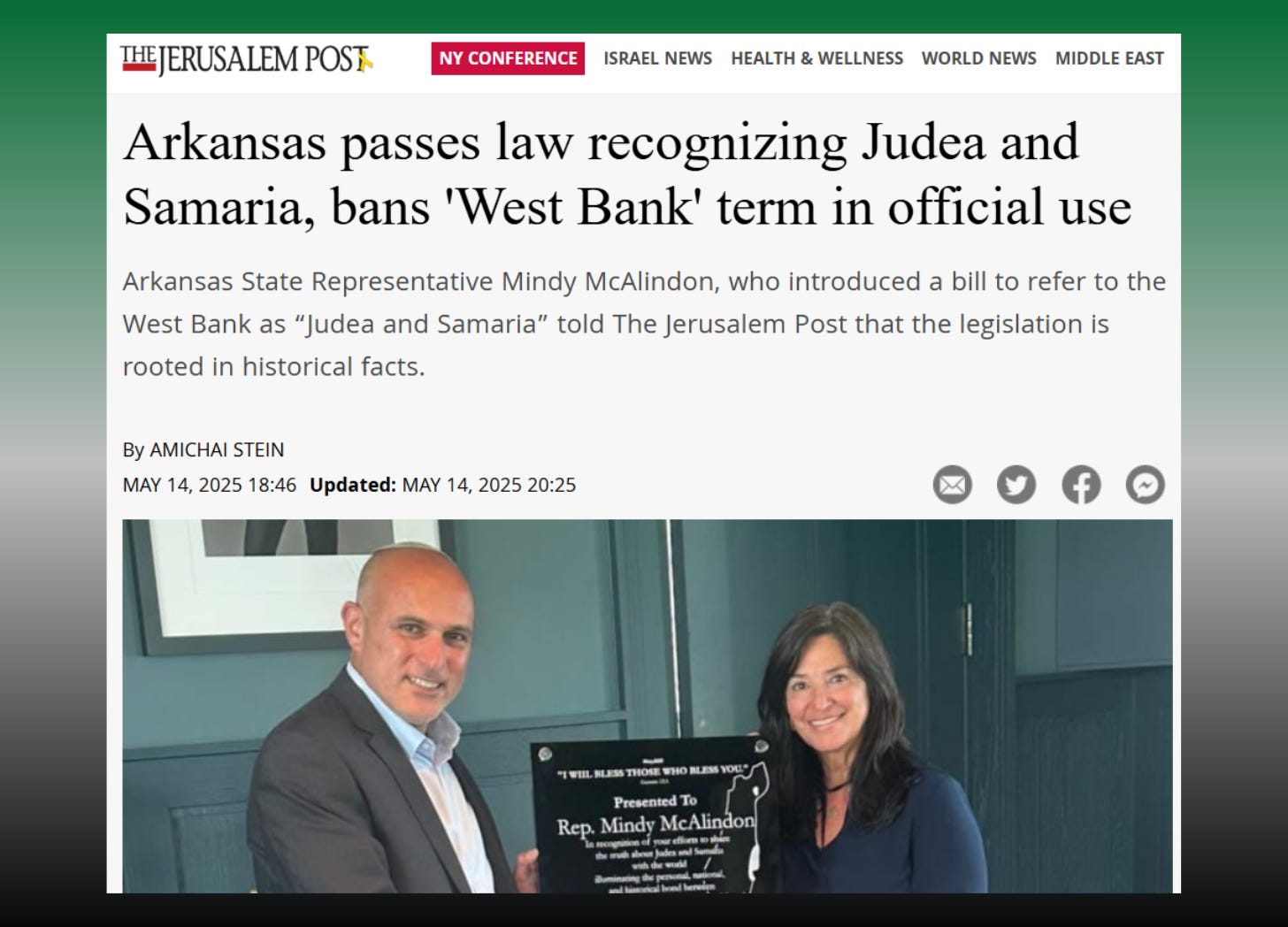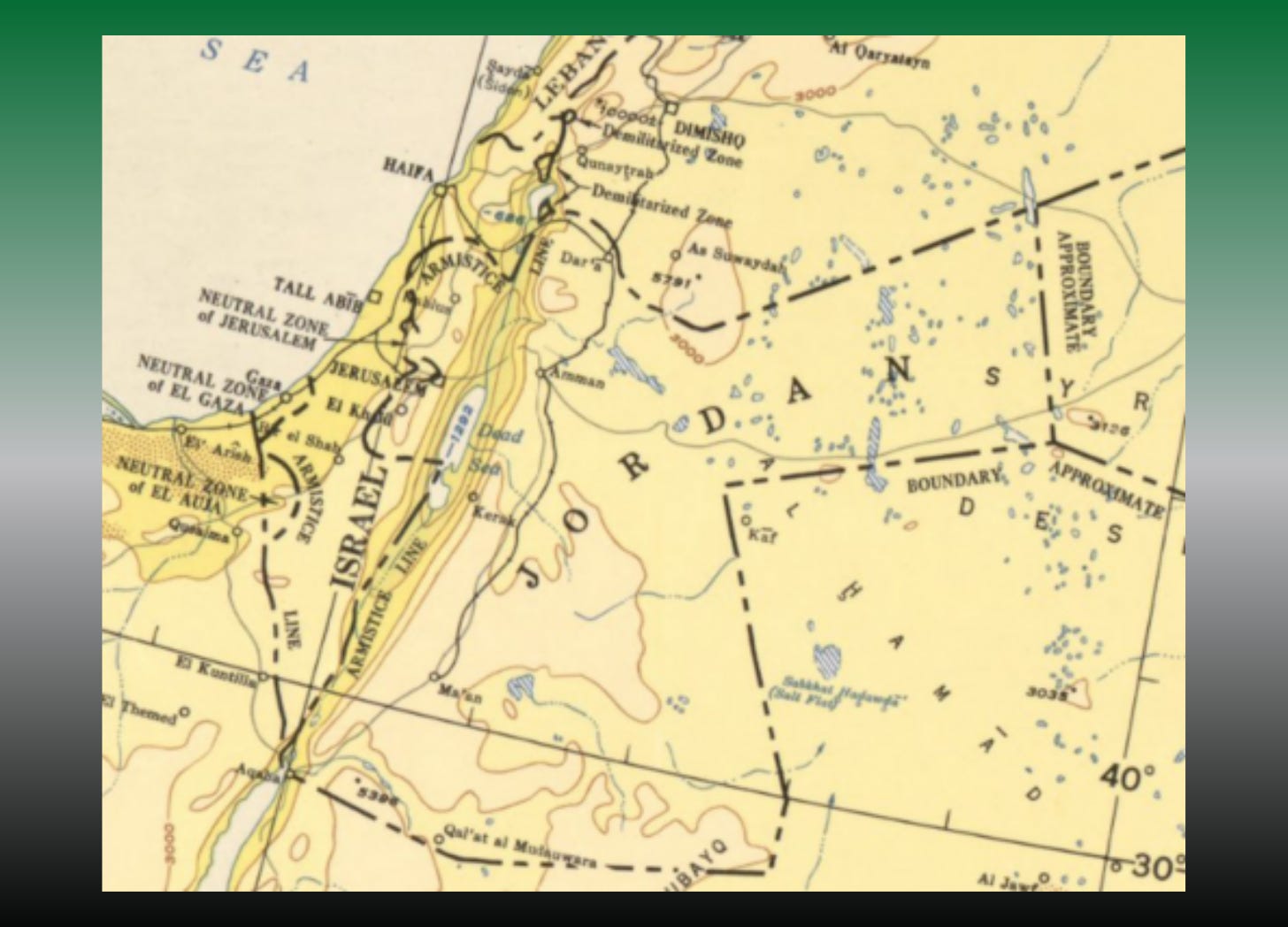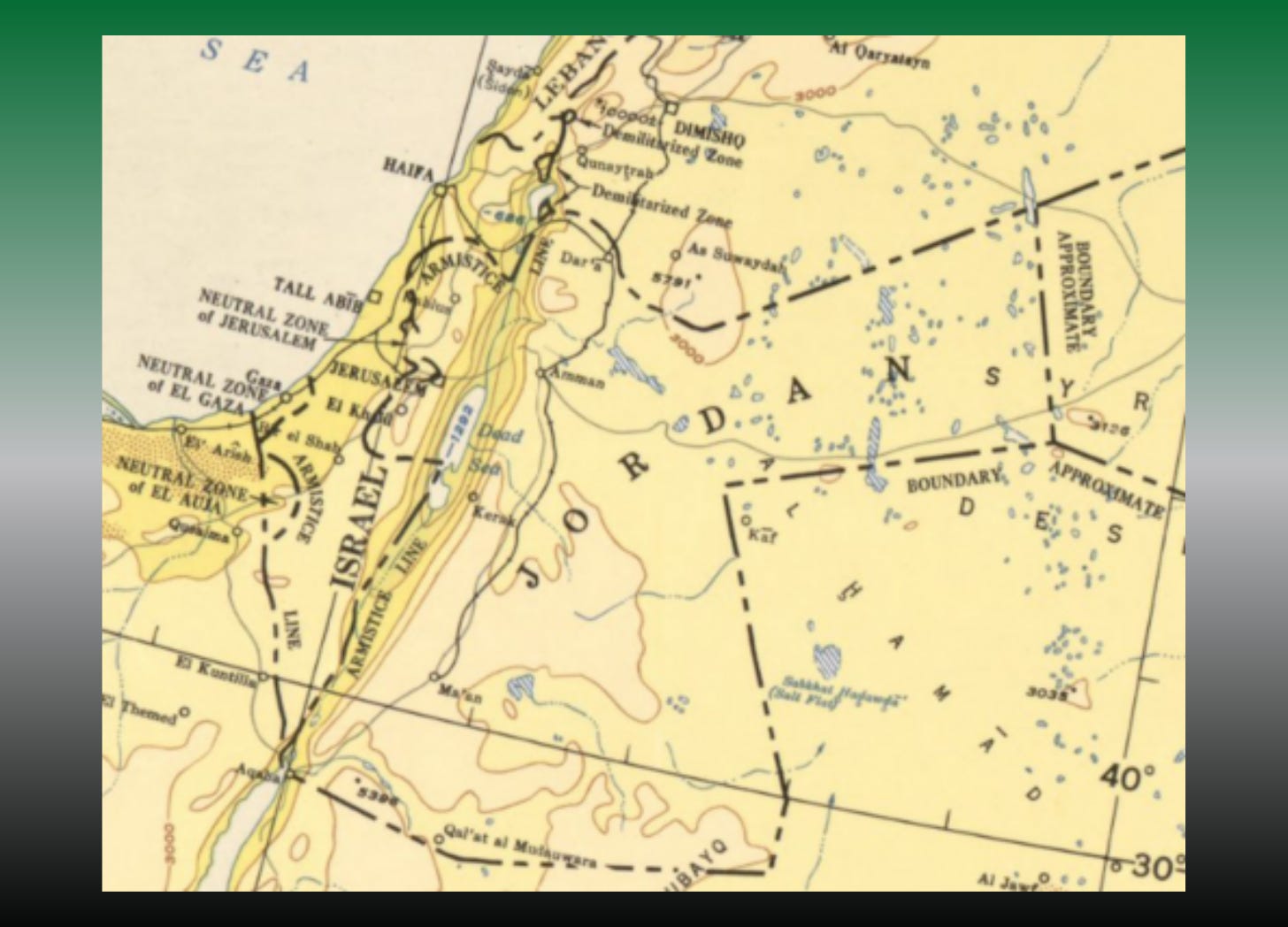Our “Maha Collective” team of citizen journalists at The Fruited Plain recently learned that the state of Arkansas passed legislation that would prohibit state agencies from using the term “West Bank” when describing the areas known as Judea and Samaria. Yes, you read that correctly. In the state of Arkansas, the “Recognizing Judea and Samaria Act” passed on or around 5/19/25.
This story was printed in the Jerusalem Post 5 days earlier on Wednesday, 5/14/25 in the event you still can’t believe that this is a real story.
When we learned this news, our entire team was also quite perplexed. Does it seem odd that the leaders from the state of Arkansas would make this state law? Why in the world would any state be passing legislation on this topic at all? And why would the state of Arkansas go rogue like this? Make this all make sense, please!
For those of you unfamiliar with the Biblical terms “Judea” and “Samaria,” here is a map showing these two areas in what we refer to as modern day Israel.
The border between Samaria and Judea is set at the latitude of Ramallah. The name "Samaria" is derived from the ancient city of Samaria, capital of the northern Kingdom of Israel. The name Judea, when used in Judea and Samaria, refers to all of the area to the south of Jerusalem, including Gush Etzion and Har Hevron. The name Samaria, on the other hand, refers to all of the area to the north of Jerusalem.
Judea and Samaria was a northern and southern delineation, Biblically speaking. The northern kingdom was Samaria and the southern kingdom was Judea.
As our team dug a little deeper into this Arkansas legislation, we became aware that similar legislation had been introduced in both the House of Representatives and the Senate a few months earlier. Were you aware of this? Of course not, as the US mainstream media (MSM) has apparently decided to remain obstinately moot on this topic. Our entire team was completely unaware of this pending legislation until we read about the Arkansas story in May.
Rep. Claudia Tenney (NY) introduced bill H.R. 902 in the House of Representatives on 1/31/25. This bill prohibits the use of the term “West Bank,” and underscores Israel’s historic and legal ties to Judea and Samaria. Note the emphasis being placed on the word “RECOGNIZING,” displayed consistently in capital letters.
Senator Tom Cotton (AR) introduced bill S.384, “RECOGNIZING Judea and Samaria,” in the Senate on 2/4/25. Again, note the word RECOGNIZING appearing in capital letters throughout.
It’s time to call this region by its rightful name and stop playing into anti-Israel propaganda. ~ Sen. Tom Cotton
Equipped with this knowledge, it would certainly appear that the state of Arkansas is out in front on this topic, anticipating that these bills in the House and the Senate will pass at the federal level and then be adopted by the states. Why do you think the state of Arkansas, of all states, would be so confident and sure that this bill will become the law of the land at the federal level? To be clear, the status of both bills in the House and Senate were marked as being “introduced” when Arkansas was passing its bill at the state level in May.
Do the legislative actions taken in Arkansas seem slightly premature?
Let’s take a step back and refresh ourselves on a little history before we proceed.
First and foremost, it is good to remember that the land of Palestine was the land of Palestine in 1947. Israel, as we know it today, did not exist until 1948.
What about the term the “West Bank?” When exactly did the term “West Bank” get introduced? 1950 or 1955 maybe? After the Jordanian annexation?
Following the December 1948 Jericho Conference, Transjordan annexed the area west of the Jordan River in 1950, naming it "West Bank" or "Cisjordan", and designated the area east of the river as "East Bank" or "Transjordan". Jordan, as it was now known, ruled over the West Bank from 1948 until 1967.
So what happened when Israel occupied the territory west of the Jordan River in 1967?
The term "West Bank" came into use to describe the territory west of the Jordan River, including the region of Judea and Samaria, after the 1949 Arab-Israeli War, when Jordan annexed the area. Following the Six-Day War in 1967, when Israel occupied the territory, the term "West Bank" continued to be used, and the Israeli military administration officially designated the area as "Judea and Samaria" in December 1967.
The actions that were taken by the US House and Senate on this topic in the early part of 2025 appear to be reversing the actions taken in 1967 after the Arab-Israeli war.
The term "West Bank" gained prominence as a descriptive term for the territory of Judea and Samaria following the Six-Day War (aka Arab–Israeli War) in 1967. Israel took control of this territory after the war. While the term "Judea and Samaria" was formally adopted by the Israeli Military Governorate in December 1967, the "West Bank" was already in use. Essentially, the "West Bank" served as a geographical designation, while "Judea and Samaria" reflected a historical and religious connection to the land for Jewish people.
Can you see the subtle shift that happened in 1967? Judea and Samaria were once defined as separate regions to the north and south, not east and west.
In December 1967, the Israeli Military Governorate issued an order that stated: "the term 'Judea and Samaria region' shall be identical in meaning for all purposes to the term 'the West Bank Region'". By early 1968, "Judea and Samaria" had been formally adopted in official usage.
Meanwhile, what exactly is happening with Palestine being recognized as it is own sovereign, independent state?
In the Kazan Declaration from 10/23/24, the 16th BRICS Summit reaffirmed support for the full membership of the State of Palestine in the United Nations, within the context of the two-state solution, according to Brasil de Fato.
While BRICS support remains mostly rhetorical, they have publicly expressed solidarity and support for Palestinian rights, including the right to self-determination and a state, according to Al Jazeera.
Based on what month and year in history did the Kazan Declaration recognize the defined borders of Palestine? Answer: June 1967
We reaffirm our support for the State of Palestine’s full membership in the United Nations in the context of the unwavering commitment to the vision of the two-state solution based on international law including relevant UNSC and UNGA resolutions and the Arab Peace Initiative that includes the establishment of a sovereign, independent and viable State of Palestine in line with internationally recognised borders of June 1967 with East Jerusalem as its capital living side by side in peace and security with Israel.
And how many countries made up BRICS as of October 2024?
The sixteenth annual BRICS (whose membership has grown from Brazil, Russia, India, China, and South Africa to also include Egypt, Ethiopia, Iran, and the United Arab Emirates) summit was held in Kazan, Russia, on October 22-October 24. 2024.
And how many countries make up BRICS as of June 2025? Answer: Alot, and the number is growing. Indonesia, the first Southeast Asian nation to join BRICS, was the most recent convert, joining BRICS in January 2025.
In addition to the growing list of BRICS nations recognizing the State of Palestine, a plethora of other entities are doing the same, including the United Nations and several countries in European Union. Of course, Israeli PM Benjamin Netanyahu has voiced that all of these EU countries are supporting terrorism.
As of November 29, 2024, 11 out of 27 EU member states have recognized the State of Palestine: Sweden, Cyprus, Hungary, the Czech Republic, Poland, Slovakia, Romania, Bulgaria, Malta, Ireland, and Spain.
What exactly is going here? Why the need for all of this “Judea and Samaria” legislation in the United States on this controversial international topic, at both the federal and state level? Has the Balfour Declaration of 1917 been rescinded, ultimately requiring this reset of territory lines for the State of Palestine and a return to the more accurate Biblical terms “Judea and Samaria?”
We thought that map that we shared earlier in this post looked familiar.
For our newest subscribers, our team shared this story on the Balfour Declaration back in October of 2023.


















